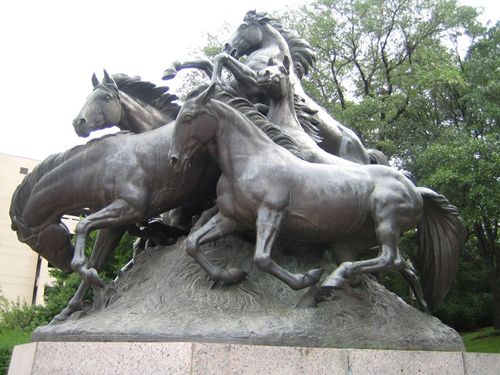Books by
Michael Barr
Order Here: |
|
|
At
first glance a West Texas mustang and a New York polo pony have
about as much in common as the Hill
Country with the Hamptons, and yet horses bred in the Texas
counties north and west of San
Antonio made important contributions to the game of polo.
Polo traveled to England from India in 1871 where the British cavalry
developed the modern game. Many historians credit James Gordon Bennett,
wealthy owner of the New York Herald, with bringing polo
to the United States in 1876.
Englishmen living in Texas and cavalry units at Fort Sam Houston
in San Antonio brought
polo to the Lone Star State, but the game retained a strong British
flavor. A fancy dinner followed many American polo games where it
was common, even in Texas, to toast the Queen of England as well
as the President of the United States.
On July 7, 1883, San Pedro Springs Park in San
Antonio and the Texas Polo Club hosted one of the first civilian
polo games in the state. The game began when the umpire, Capt. Michael
Glynn Turquand of Boerne,
placed the ball in the center of the field; then dropped his flag:
a black and white banner of the Knights Templar. At that signal
a rider from each team raced for the ball and "collided with such
force that both riders and horses were thrown to the ground."
Polo was no game for the faint of heart.
At another early game in San
Antonio a violent collision "unhorsed 2 players" and another
animal "ran over 2 spectators." "No one was seriously injured,"
the Galveston Daily News reported, "that is to say no one
was killed."
It is easy to see why Texans took to the game. A reporter offered
the opinion that polo was more popular in San
Antonio than poker which had "held sway in this city for over
a century."
A polo player was only as good as his horse, but the earliest English
polo ponies, native to the British Isles, were not well suited for
the game. They tended to be overgrown and slow. East coast American
horses were no better.
Then some genius saw the potential of Texas mustangs as polo ponies.
The rugged mustangs of the Hill
Country were athletic, agile and sure-footed. They could stop
and start with amazing speed.
The mustangs were descendants of Andalusian and Arab stock and brought
to Texas by the Spanish. They had been running wild on the Texas
range for centuries. Their only problem was a tendency to buck.
|
 |
|
The "Mustangs"
statue in front of the Texas
Memorial Museum.
Sculpted by Alexander Proctor, using wild mustangs as models.
Photo
courtesy Alex Chen, 2008
|
|
San
Antonio, the hub of Texas polo and the gateway to the Hill
Country, was uniquely positioned to bring polo and the mustang
together.
The San Antonio Daily Express reported that in the spring
of 1875 a man identified as Mr. Blassen bought a string of West
Texas horses in San Antonio.
He shipped the animals to New York where polo players used them
in one of the earliest games played on American soil.
In September 1876 James Gordon Bennett sent an agent to San
Antonio to buy polo ponies for his polo club in New York. In
September 1877 a man identified as Col. Peay of San
Antonio shipped 2 carloads of West Texas horses to England for
use as polo ponies. American businessman and polo enthusiast William
H. Vanderbilt bought Hill
Country horses in San
Antonio. American financier August Belmont (the Belmont Stakes
is named for him) bought polo ponies in the Alamo City.
Not all mustangs made good polo ponies, but the ones with an aptitude
for the game were extraordinary. Trainers taught the horses to follow
the ball and to maneuver in response to pressure from the riders'
knees as much as a tug on the reins.
By 1885 San Antonio
was a depot for polo ponies. Polo players and their representatives
from both sides of the Atlantic converged on Narciso Leal's Livestock
Exchange at 226 Dolorosa Street to buy Texas mustangs - many of
them bred in Kendall,
Gillespie,
Llano, McCullough
and San Saba
Counties.
© Michael Barr
"Hindsights"
August 15, 2017 Column
Sources:
"That Mustang Pole," Galveston Daily News, June 4, 1880.
"State Press," Galveston Daily News, August 5, 1883.
"Polo Dinner," San Antonio Light, October 24, 1883.
"Off for England," San Antonio Daily Express, September 1, 1877.
"Polo," San Antonio Daily Express, June 17, 1876.
|
|
|

 Gulf
Coast
Gulf
Coast East
Texas
East
Texas Central
North
Central
North Central
South
Central
South Panhandle
Panhandle South
Texas
South
Texas Hill
Country
Hill
Country West
Texas
West
Texas Ghost
Towns
Ghost
Towns COUNTIES
COUNTIES